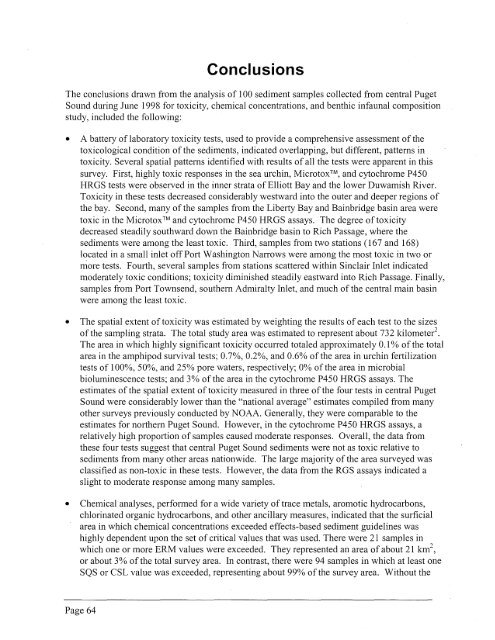Sediment Quality in Puget Sound Year 2 - Center for Coastal ...
Sediment Quality in Puget Sound Year 2 - Center for Coastal ...
Sediment Quality in Puget Sound Year 2 - Center for Coastal ...
You also want an ePaper? Increase the reach of your titles
YUMPU automatically turns print PDFs into web optimized ePapers that Google loves.
Conclusions<br />
The conclusions drawn from the analysis of 100 sediment samples collected from central <strong>Puget</strong><br />
<strong>Sound</strong> dur<strong>in</strong>g June 1998 <strong>for</strong> toxicity, chemical concentrations, and benthic <strong>in</strong>faunal composition<br />
study, <strong>in</strong>cluded the follow<strong>in</strong>g:<br />
A battery of laboratory toxicity tests, used to provide a comprehensive assessment of the<br />
toxicological condition of the sediments, <strong>in</strong>dicated overlapp<strong>in</strong>g, but different, patterns <strong>in</strong><br />
toxicity. Several spatial patterns identified with results of all the tests were apparent <strong>in</strong> this<br />
survey. First, highly toxic responses <strong>in</strong> the sea urch<strong>in</strong>, MicrotoxTM, and cytochrome P450<br />
HRGS tests were observed <strong>in</strong> the <strong>in</strong>ner strata of Elliott Bay and the lower Duwamish River.<br />
Toxicity <strong>in</strong> these tests decreased considerably westward <strong>in</strong>to the outer and deeper regions of<br />
the bay. Second, many of the samples from the Liberty Bay and Ba<strong>in</strong>bridge bas<strong>in</strong> area were<br />
toxic <strong>in</strong> the MicrotoxTM and cytochrome P450 HRGS assays. The degree of toxicity<br />
decreased steadily southward down the Ba<strong>in</strong>bridge bas<strong>in</strong> to Rich Passage, where the<br />
sediments were among the least toxic. Third, samples from two stations (167 and 168)<br />
located <strong>in</strong> a small <strong>in</strong>let off Port Wash<strong>in</strong>gton Narrows were among the most toxic <strong>in</strong> two or<br />
more tests. Fourth, several samples from stations scattered with<strong>in</strong> S<strong>in</strong>clair Inlet <strong>in</strong>dicated<br />
moderately toxic conditions; toxicity dim<strong>in</strong>ished steadily eastward <strong>in</strong>to Rich Passage. F<strong>in</strong>ally,<br />
samples from Port Townsend, southern Admiralty Inlet, and much of the central ma<strong>in</strong> bas<strong>in</strong><br />
were among the least toxic.<br />
The spatial extent of toxicity was estimated by weight<strong>in</strong>g the results of each test to the sizes<br />
of the sampl<strong>in</strong>g strata. The total study area was estimated to represent about 732 kilometer!<br />
The area <strong>in</strong> which highly significant toxicity occurred totaled approximately 0.1 % of the total<br />
area <strong>in</strong> the amphipod survival tests; 0.7%, 0.2%, and 0.6% of the area <strong>in</strong> urch<strong>in</strong> fertilization<br />
tests of 10096, 50%, and 25% pore waters, respectively; 0% of the area <strong>in</strong> microbial<br />
biolum<strong>in</strong>escence tests; and 3% of the area <strong>in</strong> the cytochrome P450 HRGS assays. The<br />
estimates of the spatial extent of toxicity measured <strong>in</strong> three of the four tests <strong>in</strong> central <strong>Puget</strong><br />
<strong>Sound</strong> were considerably lower than the "national average" estimates compiled from many<br />
other surveys previously conducted by NOAA. Generally, they were comparable to the<br />
estimates <strong>for</strong> northern <strong>Puget</strong> <strong>Sound</strong>. However, <strong>in</strong> the cytochrome P450 HRGS assays, a<br />
relatively high proportion of samples caused moderate responses. Overall, the data from<br />
these four tests suggest that central <strong>Puget</strong> <strong>Sound</strong> sediments were not as toxic relative to<br />
sediments from many other areas nationwide. The large majority of the area surveyed was<br />
classified as non-toxic <strong>in</strong> these tests. However, the data from the RGS assays <strong>in</strong>dicated a<br />
slight to moderate response among many samples.<br />
Chemical analyses, per<strong>for</strong>med <strong>for</strong> a wide variety of trace metals, aromotic hydrocarbons,<br />
chlor<strong>in</strong>ated organic hydrocarbons, and other ancillary measures, <strong>in</strong>dicated that the surficial<br />
area <strong>in</strong> which chemical concentrations exceeded effects-based sediment guidel<strong>in</strong>es was<br />
highly dependent upon the set of critical values that was used. There were 2 1 samples <strong>in</strong><br />
which one or more ERM values were exceeded. They represented an area of about 2 1 km2,<br />
or about 3% of the total survey area. In contrast, there were 94 samples <strong>in</strong> which at least one<br />
SQS or CSL value was exceeded, represent<strong>in</strong>g about 99% of the survey area. Without the<br />
Page 64







